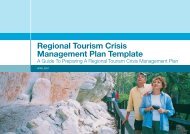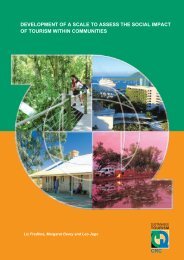Tourism Risk Management - Sustainable Tourism Online
Tourism Risk Management - Sustainable Tourism Online
Tourism Risk Management - Sustainable Tourism Online
Create successful ePaper yourself
Turn your PDF publications into a flip-book with our unique Google optimized e-Paper software.
safety equipment, evacuation procedures, environmental conditions; and<br />
• insurance (requires safety compliance).<br />
Resumption of tourism operation and business following high profile transport accidents is often<br />
dependent on the extent of operator culpability and the effectiveness of subsequent public relations.<br />
Crisis communications should be timely, express appropriate sympathy/empathy/sensitivity and be<br />
based on the established facts. Where possible, the incident should be contextualized within a<br />
broader history or record for safety and visitor satisfaction. There should also be adequate victim<br />
and family support. Effective recovery usually requires a demonstrated ability to communicate and<br />
address the safety concerns of prospective clientele.<br />
(Source: ABC News, 2006; BBC News, 2006; and DFAT, 2006)<br />
National Disaster <strong>Management</strong> Arrangements in Asia and the Pacific<br />
National Disaster <strong>Management</strong> Councils exist in one form or another in most Asian and Pacific<br />
nations where the past decade or so has seen a paradigm shift from relief and response activities to<br />
a comprehensive disaster risk management framework. In general, disaster management and risk<br />
reduction strategies are linked to national and international drivers including economic development<br />
and poverty reduction strategies and the UN Millennium Development Goals.<br />
National Disaster <strong>Management</strong> Councils (or equivalent agencies) provide advice to governments,<br />
develop policies and strategic directions in disaster management, coordinate activities, and provide<br />
frameworks within which plans can be developed and implemented. In general, disaster management<br />
responsibilities are allocated to national, state/provincial, district and local governments. The main<br />
responsibilities of the national governments are to develop and maintain relevant legislation, allocate<br />
responsibilities, provide national security, stability and prosperity and to provide strategic directions.<br />
The district and local level governments are normally tasked to provide services, amenities and<br />
controls for the health and well-being of their communities.<br />
The systems for disaster management in Asia follow similar general patterns but there is no<br />
consistent model. However, the recent and widespread shift from response and relief to communitybased,<br />
comprehensive disaster risk management programs includes a focus upon partnerships<br />
between national and local governments and non-governmental organizations to promote risk<br />
reduction and disaster preparedness. The requirements and input of tourism operators and<br />
associations are consistent with this multi-focus, community-based approach to disaster and crisis<br />
management.<br />
Examples of national disaster management arrangements in Asia and the Pacific include:<br />
• The Philippines’ National Disaster Coordinating Council which was established by Presidential<br />
decree in 1978 as the highest policy-making body on disaster-related matters. There are also<br />
regional and several levels of local coordinating councils.<br />
• Viet Nam is subject to flood, typhoon and drought and these are being addressed through the<br />
Second National Strategy for Disaster Mitigation and <strong>Management</strong> (2001–2010) which has<br />
identified mitigation measures and principles and the key tasks of the National Committee for<br />
Disaster Mitigation and <strong>Management</strong>.<br />
• Thailand has a National Civil Defence Committee as well as plans for disaster management at<br />
each level, with support from the national level. In October 2002 a new department of Disaster<br />
Preparedness and Mitigation was established in the Ministry of Interior, consolidating<br />
functions previously undertaken by several departments.<br />
<strong>Tourism</strong> <strong>Risk</strong> <strong>Management</strong> – An Authoritative Guide to Managing Crises in <strong>Tourism</strong> 47
















